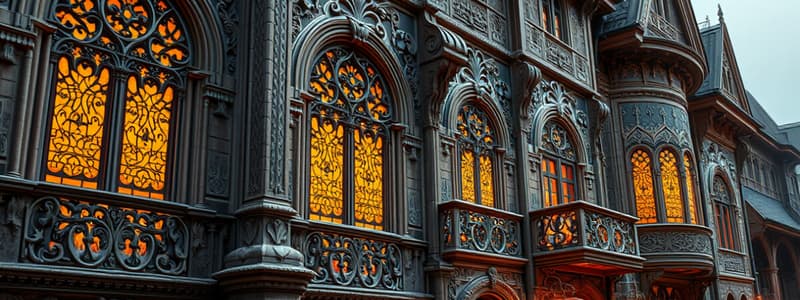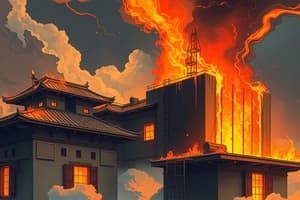Podcast
Questions and Answers
What is the primary benefit of fire-resistive construction?
What is the primary benefit of fire-resistive construction?
- It is easy to modify
- It contributes fuel to a fire
- It is the most resistant to collapse and does not contribute fuel to a fire (correct)
- It is inexpensive to build
What are the two primary materials used in fire-resistive construction?
What are the two primary materials used in fire-resistive construction?
- Steel and concrete (correct)
- Brick and aluminum
- Glass and rubber
- Wood and plastic
What is concrete composed of?
What is concrete composed of?
- Sand, water, and metal
- Portland cement, water, and aggregates (correct)
- Clay, lime, and straw
- Plastic, rubber, and glass
What is the main weakness of concrete in construction?
What is the main weakness of concrete in construction?
What are Reinforcing Bars (Rebar) used for in concrete?
What are Reinforcing Bars (Rebar) used for in concrete?
What is Spalling in the context of concrete?
What is Spalling in the context of concrete?
What is the primary reason for using fire-resistive construction in buildings?
What is the primary reason for using fire-resistive construction in buildings?
Which of the following statements about concrete is accurate?
Which of the following statements about concrete is accurate?
What happens to steel when it is heated?
What happens to steel when it is heated?
How does the loss of roof structure affect wall stability?
How does the loss of roof structure affect wall stability?
What is the main reason for reinforcing concrete with steel?
What is the main reason for reinforcing concrete with steel?
What occurs as a result of interaction between concrete and heated steel during a fire?
What occurs as a result of interaction between concrete and heated steel during a fire?
What is a key feature of Precast Concrete Panels?
What is a key feature of Precast Concrete Panels?
What defines Tilt-Up Construction?
What defines Tilt-Up Construction?
What risk does modifying buildings with concentrated fire loads pose?
What risk does modifying buildings with concentrated fire loads pose?
What happens to steel under high heat in Type I construction?
What happens to steel under high heat in Type I construction?
What should be the priority for firefighters when dealing with heated steel?
What should be the priority for firefighters when dealing with heated steel?
At what critical temperature does steel begin to elongate significantly?
At what critical temperature does steel begin to elongate significantly?
What risk is associated with prefabricated metal buildings in fire situations?
What risk is associated with prefabricated metal buildings in fire situations?
What action should be taken if cooling steel becomes too dangerous during a fire?
What action should be taken if cooling steel becomes too dangerous during a fire?
What impact does inadequate code enforcement have on fire safety?
What impact does inadequate code enforcement have on fire safety?
What led to the Skyline Plaza Towers collapse in 1973?
What led to the Skyline Plaza Towers collapse in 1973?
What does the term 'Plastic Design' refer to in steel construction?
What does the term 'Plastic Design' refer to in steel construction?
Why is pre-fire planning vital for firefighters in buildings with steel structures?
Why is pre-fire planning vital for firefighters in buildings with steel structures?
What defines on-site concrete?
What defines on-site concrete?
What is the primary benefit of reinforced concrete?
What is the primary benefit of reinforced concrete?
Which of the following best describes prestressed concrete?
Which of the following best describes prestressed concrete?
What is the function of composite columns?
What is the function of composite columns?
What is a significant fire resistance issue with reinforced concrete?
What is a significant fire resistance issue with reinforced concrete?
What purpose do temperature rods serve in concrete?
What purpose do temperature rods serve in concrete?
What occurs to concrete at temperatures exceeding 572°F (300°C)?
What occurs to concrete at temperatures exceeding 572°F (300°C)?
What is the purpose of fireproofing in steel structures?
What is the purpose of fireproofing in steel structures?
How is encasement used as a fireproofing method?
How is encasement used as a fireproofing method?
What can lead to the failure of post-tensioned concrete during a fire?
What can lead to the failure of post-tensioned concrete during a fire?
What is the function of dynamic fire protection?
What is the function of dynamic fire protection?
What is classified as passive fire protection?
What is classified as passive fire protection?
What advantages arise from combining passive and dynamic fire protection systems?
What advantages arise from combining passive and dynamic fire protection systems?
What is the role of concrete cover in fire-resistant design?
What is the role of concrete cover in fire-resistant design?
What causes spalling in concrete?
What causes spalling in concrete?
Study Notes
Fire-Resistive Construction
- The primary benefit of fire-resistive construction is its high resistance to collapse and lack of fuel contribution during a fire.
- Key materials in fire-resistive construction include steel and concrete, known for their strength.
Concrete Composition and Properties
- Concrete is made from Portland cement, water, and aggregates.
- It exhibits weakness in tensile strength and shear resistance, despite being strong in compression.
Reinforcement Techniques
- Reinforcing bars (rebar) are used to enhance the tensile strength of concrete structures.
- Spalling refers to the loss of surface material from concrete when exposed to heat.
Types of Concrete
- Cast-in-place concrete is molded and cured at its final location.
- Prestressed concrete utilizes tensioned steel tendons to offset tensile stresses, improving structural performance.
Column Design
- Composite columns combine steel and concrete to optimize compressive and tensile strengths.
- Fire resistance concerns for reinforced concrete include potential damage from spalling and heating of steel reinforcements.
Temperature Effects
- Temperature rods are incorporated to resist cracking due to thermal changes.
- Exposure to high temperatures (above 572°F or 300°C) can lead to evaporation of moisture, causing structural weaknesses.
Fireproofing Techniques
- Fireproofing of steel structures is critical to maintain their integrity during fires.
- Encasement involves covering steel with protective materials like concrete or gypsum board to enhance fire resistance.
Fire Protection Systems
- Dynamic fire protection uses sprinkler systems to cool steel during a fire.
- Passive fire protection utilizes fireproof coatings directly on steel for protection.
Concrete Fire Resistance
- Concrete, recognized for its mass and density, effectively resists fire spread, making it an excellent material for fire-resistive design.
- Concrete cover in fire-resistant design protects reinforcement steel and delays loss of strength during exposure to fire.
Risks and Structural Interaction
- Unprotected steel is vulnerable to fire, posing a risk of structural collapse.
- Tower cranes may shift out of plumb when exposed to heat, compromising structural stability.
Structural Dynamics in Fire
- Thermal expansion of steel can lead to buckling or twisting of structural elements under high heat.
- Loss of roof structure can destabilize walls, particularly in tilt-up construction.
Precast and Tilt-Up Construction
- Precast concrete panels are manufactured off-site and transported to the construction site for quick installation.
- Tilt-up construction involves casting concrete panels on-site and lifting them into place.
Building Modifications and Fire Loads
- Modifications that introduce combustible materials can significantly increase fire risks.
- Fire behavior in type I construction may result in steel elongation under heat, affecting structural integrity.
Firefighter Safety and Procedures
- Firefighters should apply water to cooled steel to prevent structural collapse during active fires.
- Establishing collapse zones is essential when cooling steel is too hazardous.
Regulatory and Historical Context
- Inadequate code enforcement can lead to increased fire risks and potential liability for municipalities.
- The Skyline Plaza Towers collapse in 1973 was a result of the removal of shoring, leading to a progressive failure.
Steel Construction Concepts
- "Plastic design" in steel construction refers to the redistribution of loads across the structure, allowing for lighter materials.
- Pre-fire planning is essential for firefighters to formulate effective strategies tailored to fire resistance requirements of buildings.
Studying That Suits You
Use AI to generate personalized quizzes and flashcards to suit your learning preferences.
Description
Test your knowledge on fire-resistive construction with this quiz. It contains 40 multiple-choice questions focusing on the benefits, materials, and principles of effective fire-resistant building techniques.




